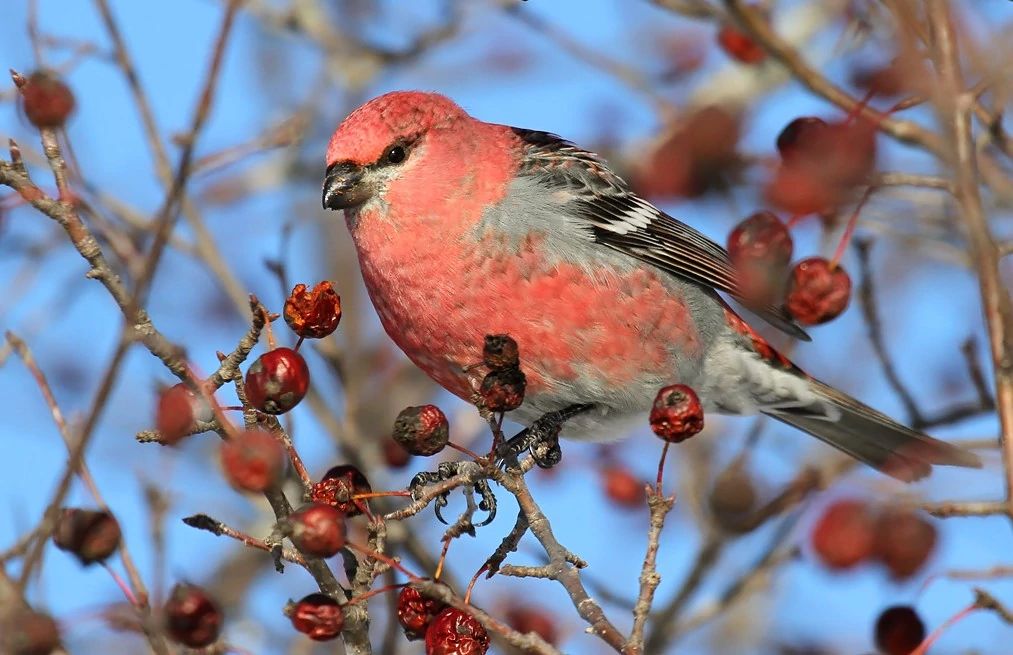Contact: Ryan Brady, DNR Conservation Biologist
ryan.brady@wisconsin.gov or 715-685-2933
Winter Brings Bounty Of Boreal Birds To Wisconsin
Learn How To Participate In This Year’s Christmas Bird Count And Get Feeder Tips
 Pine grosbeaks are among the "winter finches" arriving in great numbers in Wisconsin and other parts of the eastern U.S.
Photo credit: Ryan Brady
Pine grosbeaks are among the "winter finches" arriving in great numbers in Wisconsin and other parts of the eastern U.S.
Photo credit: Ryan Brady
MADISON, Wis. – With more people spending time at home, birdwatching has become a welcome respite during the pandemic. Heading into 2021, birds continue to brighten the Wisconsin landscape, including some in numbers not seen in years.
Pine siskins, evening grosbeaks and other “winter finches” have descended out of the Canadian boreal forest into the eastern United States, providing birdwatchers welcome excitement that promises to take some of the chill out of this winter season.
“Many of these northern species had banner nesting seasons,” said Ryan Brady, Wisconsin Department of Natural Resources’ Conservation Biologist. “But then poor tree seed and fruit crops across Canada forced the birds south in search of food.”
It’s not uncommon for one or two of these northern species to overwinter in Wisconsin. Still, this season has already seen unusually good numbers in six or seven species, an event dubbed by researchers as a “superflight.”
First came red-breasted nuthatches and purple finches in late summer, then droves of pine siskins in early fall, and soon after both were white-winged and red crossbills. Late October and early November brought more evening grosbeaks than any year in recent history. Pine grosbeaks and Bohemian waxwings weren’t far behind in the north woods, while redpolls soon spread statewide.
Many of these species are attracted to backyard feeders, especially as winter progresses and local supplies of natural foods are exhausted. The single best seed to offer is black oil sunflower, which has high fat content and attracts the most species. Small finches like siskins and redpolls, however, prefer nyjer (thistle), while white millet and suet can be great additions for ground-feeders and woodpeckers, respectively.
In addition to food, a heated water dish that is deep enough for birds to drink from but not bathe in is great for attracting winter finches and resident species. Every week or two, clean all food and water sources to minimize diseases like salmonellosis to keep birds healthy.
Find more tips for winter backyard bird feeding on DNR’s Birding and Bird Conservation webpage.
How To Participate In Christmas Bird Count
This year’s superflight should be well documented by participants in the Audubon’s 121st Christmas Bird Count, which runs Dec. 14 - Jan. 5. One of the largest and longest-running citizen science projects in the world, the Christmas Bird Count provides a snapshot of North America’s early winter bird populations and the only broad-scale assessment of their trends over time.
“The Christmas Bird Count is a great way to make your bird sightings count for conservation,” Brady said. “It’s also easy and safe to participate in your backyard or beyond.”
Each count is conducted on a single day where volunteer bird watchers scour a pre-established, 15-mile diameter circle. Wisconsin has over 100 circles across many areas of the state. To view a map of the circles expected to be included in the Christmas Bird Count and details on how to participate, click here.

